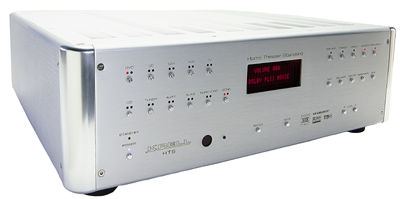Krell Home Theater Standard 7.1 surround processor

Description and Setup
The HTS 7.1 matches the style of the entire Krell KAV series, with a brushed and polished aluminum chassis that is less laid-back than the company's more conservatively styled, 2-channel-oriented Class A series. A full set of front-panel buttons provides access to all the usual operations, as does the small remote. User feedback is provided by the unit's small LED display or onscreen menus. Around back, an ample set of inputs and outputs permits balanced or unbalanced operation.
Surround operations are handled by two Crystal Digital signal processors, the CS49623 and CS493302. All digital signals are upsampled to 24-bit/88MHz precision for internal processing. The digital high-and lowpass filters run at double precision (48-bit). The analog stages, with a rated bandwidth of 1MHz, use Krell's Current Tunnel topology, developed for the company's Class A Series 2-channel preamp.
Standard features include a full complement of operating modes, including a number of music surround formats for simulating surround from 2-channel sources. FM discussed these in his review of the HTS 2 (available online at www.guidetohometheater.com). Suffice it to say that Krell's, unlike the simulated surround modes in most surround processors and receivers, are well worth experimenting with. If you don't like them, 2-channel stereo is available at the touch of a button on the remote.
There are a zillion other things I could discuss about the operation of the HTS 7.1, but I'll resist the temptation to cover everything that appears in the 75-page owner's manual. One thing you'll want to know, however, is how this update differs from the HTS 2. There are added music and film surround modes: Dolby Pro Logic II Movie and Music (unlike the original Pro Logic, which was designed solely for film, Pro Logic II is suitable for music as well as matrixed Dolby Surround film soundtracks), DTS Neo:6 Music and Cinema, THX Surround EX, Dolby Digital EX, and DTS 6.1 ES Matrix and Discrete. THX can be switched in or out of all film surround modes, including EX and DTS ES, by repeatedly pushing the THX button on the remote. There's a 7.1 analog surround bypass mode for DVD-Audio and SACD. Both of these formats are currently native 5.1, so you're unlikely to need the extra two inputs for surround back channels, but they're provided anyway. The HTS 7.1 sports several available crossover points (40Hz, 60Hz, 80Hz, 100Hz, or 120Hz) vs the single 80Hz point of the HTS 2, though a single point must be selected for all crossed-over speakers. And all 7.1 channels now have 24-bit/192kHz DACs.
Setup is performed using the onscreen display (OSD) menus. These are available from all three flavors of video outputs: composite, S-video, and component. Composite and S-video provide two monitor outputs each, one with OSD, the other without. But component has only one set of outputs, and these provide OSD. If you use the component output, one way to keep an indicator from popping up every time you change the volume level is to shut off the menu; you can do this by going into the Operation setup menu and changing the OSD "On" time to "0." Another option is to set the component input to the Progressive/HD setting, which disables that input only.
Like all sophisticated surround processors, the HTS 7.1 is relatively complex, but the sequences provided by the OSD menus made setup painless. After you connect all the inputs, you access the main menu to designate the speaker setup (5.1, 6.1, or 7.1), the bass range for each speaker (Limited or Full Range), and the crossover frequency to the subwoofer. There are also the usual speaker-level and distance settings; you can calibrate the levels with the processor's own test signal, which can cycle between the speakers automatically or manually, or you can use an outboard signal of your choosing—possibly from the Video Essentials or Avia Guide to Home Theater test DVDs.
After setup and calibration, you designate which input buttons will be linked to the input jacks you've used. Any input can be assigned to any button (or you can use the factory defaults, if they're suitable). Analog audio inputs, digital audio inputs, and video inputs are separately assignable. There are ample inputs for almost any application; about the only one missing is an RF input for Dolby Digital laserdiscs—a rare feature on any of the current crop of surround processors.
Limitations and glitches? Not many, but a few worth mentioning. As FM noted of the HTS 2, the HTS 7.1 also tends to cut off the first few milliseconds of a CD as it locks on and settles down. It does the same with the occasional DVD; the sound on the THX logo that opens Ice Age, for example, was truncated a bit. On more than one occasion, I got no sound when I switched to an input; cycling to another input and back again invariably corrected the problem. You can't set up separate operating parameters (Full Range or Limited response for selected channels, crossover frequency, levels, etc.) for different sources, though there is a bass-level trim for music-only sources.
- Log in or register to post comments















































